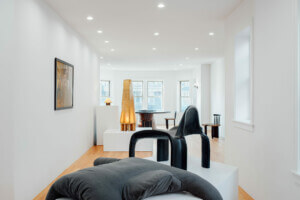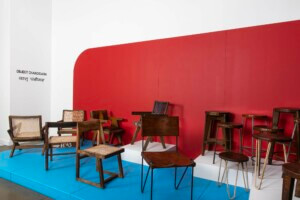When Jean Lin founded Colony in 2015, she established a new kind of platform for New York City’s thriving community of independent furniture, lighting, textile, and object designers. The multihyphenate creative—a fashion designer, editor, trend forecaster, professor, entrepreneur, and consultant—set up the gallery based on a co-op fee system rather than the standard commission model. This made it a more feasible and attractive option for many of the city’s emerging talents. Today, Colony’s roster includes design studios like Fort Standard, Allied Maker, Moving Mountains, Vonnegut/Kraft, Earnest Studio, and Hiroko Takeda, to name a few. Lin has also spearheaded initiatives such as the charitable design organization Reclaim NYC and the Tribeca Design District event. She is also a member of the NYCxDesign Steering Committee and on the board of the Female Design Council. As a member of this year’s AN Best of Products Awards jury, Lin spoke to The Architect’s Newspaper contributor Adrian Madlener about the current state of furniture and product design while touching on the issues facing the industry and changes that have taken place in the past few years.
The Architect’s Newspaper: What are some of the challenges for independent designers today?
Jean Lin: Independent designers are the most prone to the impact of a changing economy—it affects them on a micro level. For many of the talents that show at Colony, the difficulty is in determining whether they can grow while staying true to their initial goals. Right now, they might be manufacturing their own furniture. If they decide to hire new people or outsource production, how will they be able to maintain the identity of their practice?
AN: Are these talents addressing or shying away from some of the larger problems society is currently dealing with, such as sustainability, the pace of technological advancement, or gender-based, racial, and economic inequalities?
JL: What these small companies do is personal. It’s hard to miss what they’re about. The designers I work with are very socially and environmentally conscious. A lot of the causes that are getting wide, mainstream attention now have been addressed by this community for a long time. Seattle-based duo Grain had a ten-year anniversary exhibition at Colony in September. They are sourcing materials responsibly, and their entire practice is based on sustainability. It’s inherent to what they do, and so they don’t need to promote it as something radical.
AN: Can these issues also be addressed through aesthetics and form?
JL: Good design is always about the interaction between an object and the environment it occupies—the people it interfaces with. There are ways that we can talk about social and ecological issues through form and aesthetics. Is the product masculine or feminine? How long does that piece last versus how long will that piece seem appealing? However, I wouldn’t say that what’s coming out now is a direct visual or formal reflection of everything that’s going on in the world. What designers are now taking into closer consideration is how they source material, what companies and vendors they decide to collaborate with, and how they run their businesses. Sometimes, it’s simply a question of being active and not apathetic toward the things that are changing in the world around them. That awareness seeps into everything they do.
AN: How do these changes in the way talents work affect trends?
JL: The talents that are leading the way are now pushing themselves to create timeless pieces. This is a reaction to Instagram culture, the latest and flashiest designs that often look the same, go viral, and get all the attention—but only for a fleeting moment. I love trends and believe they become popular for valid reasons, mainly because they are approachable at the given time. Right now, monolithic forms and earthen jewel tones are all the rage, but next year we could be talking about much more delicate shapes and a different color palette. Trends get pushed to their threshold and spark antitrends that then take over. The designers that show at Colony are using material, but in an aesthetic and formal language that can last much longer.
AN: Do the collectible and art design markets create economic conditions that give independent designers the time and space necessary to develop these types of designs?
JL: I don’t see the collectible design market as something that has a great impact on the wider design industry. It’s aspirational and only targeted to the 1 percent of people who are able to afford a luxury item that isn’t necessarily functional, and perhaps it’s more reflective of artistic expression. What truly pushes designers to innovate is a different kind of high-end market that is educated in the quality of craftsmanship and the value of good design. Emerging designers are finding a comfortable place in the market. The upper middle class, interior designers, and the hospitality industry are starting to appreciate the quality of this output. In turn, there is a demand for beautiful, functional, and well-crafted work that doesn’t have to sit on a shelf to be acknowledged.
AN: You mentioned that interior designers are important clients. This is especially true in New York City, where a strong surge in real estate is keeping the industry busy. How are independent designers faring in other parts of the country?
JL: This summer, Colony and Design Milk launched an initiative called Coast to Coast to help dispel the misconception that the only design market in the United States is New York. I think that this city is an amazing commercial and creative center for design. I also think that the sentiment that people never have to leave because all the best talents come or sell here is too insular and no longer accurate. We visited Detroit, Nashville, New Orleans, and Santa Fe to get a better understanding of how the independent design movement has expanded. Many local or transplanted talents are becoming a force for good in their communities, helping to change the market and creative landscape. I’m now planning to orient Colony with a broader focus and to incorporate design from different parts of the country.
AN: The independent design or maker’s movement has been going strong for the past 15 years or so. Is there a potential for autonomous talents to collaborate with larger manufacturers and the contract market?
JL: It would be a challenge. A lot of independent talents have altogether discounted the possibility of collaborating with big companies. The gap between these two areas of design is wider than ever. Unlike in Europe, major manufacturers and design brands in the United States don’t have the time to dig in and find talents who aren’t on a top 10 list. They’re always going to go with the star designers they’ve worked with before. This reality forces and facilitates independent design companies to grow, out of necessity. However, large companies definitely look to young and emerging talents as a resource, even if they don’t give credit where credit is due. As independent practices become a stronger commercial force, this will happen even more. The good news is that consumers are also seeing the value of well-made furniture and product design, even if it has to be sold at a higher price point.











